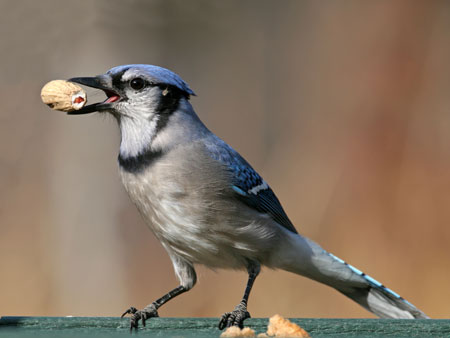Cyanocitta cristata
The Blue Jay is a bird with a rather mixed reputation. They can be noisy and boisterous. They sometimes bully their way around the birdfeeder. They have poor table manners when eating mixes with a variety of differently sized seeds. Blue Jays will shovel small seeds out of the way with their bills, as they hunt for the sunflower seeds, corn, and nutmeats they prefer. A mix comprised of only large seeds, like Aspen Song® Cardinal Mix solves this problem. Some of their food choices away from the feeder are also problematic.

Blue Jay
But set all that aside for a moment and take in the sight of a Blue Jay. They truly are handsome birds. From our perspective, the sexes look alike. This crested member of the corvid family is tailored in beautiful shades of blue, grey, white, and black. Note the black bars and white tips of the Blue Jay’s tail. The black eyeline and collar across the breast and sides of the neck give the Blue Jay a “formal attire” appearance.
Blue Jays are commonly found in towns and villages. They especially like these areas when mast-producing trees are present. Mast refers to the seeds of plants that produce large nuts: e.g., beechnuts, acorns, hazelnuts, and hickory nuts. These constitute the favorite food choices of Blue Jays. And they cache large quantities of the nuts for winter retrieval. Unused caches may be an important source for the propagation of these beautiful trees. Blue Jays are omnivores: consumers of a wide variety of food types. Here is where their reputation suffers. They consume farmers’ grains (especially corn), wild fruits, grasshoppers, caterpillars, beetles, other birds’ eggs and young, amphibians, and rodents.
Blue Jays are excellent mimics of other birds’ songs and even man-made sounds. Their own vocalizations include: “jay…jay” and “queedle…queedle.” Jays are not particularly gregarious. Pairs and their young live separately from neighboring Jays. Territories are rather loosely defined between families. The one time they do get together is when a predator is in the neighborhood. Hawks and owls are “mobbed” by groups of Jays to drive them from the area. Other targets of Blue Jay mobbing include cats, snakes, squirrels, and humans when they approach a nest site too closely.
Blue Jays are opportunists. This is their survival strategy. The degree to which they prey on other birds is poorly studied and may be overstated. In any case, they will find your seed feeders and will present their appearance, vocalizations, and personalities for your review.
Reference
Tarvin, Keith A. and Glen E. Woolfenden. 1999. Blue Jay (Cyanocitta cristata), The Birds of North America Online (A. Poole, Ed.). Ithaca: Cornell Lab of Ornithology.